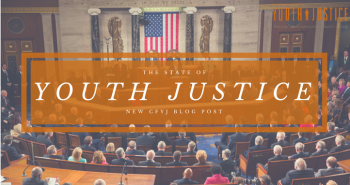The State of Youth Justice

By Rachel Marshall, Federal Policy Counsel
Today is President Trump’s first State of the Union address. As he prepares to address the nation and outline his priorities for the year, we thought it fruitful to write our own “State of Youth Justice” address.
The first year of the Trump administration saw opportunities for progress as well as setbacks for our nation’s justice-involved youth. At a time where youth arrests and incarceration are at a 40-year-low, there are great opportunities for the administration to promote public safety while supporting vulnerable youth by:
1. Signing a Reauthorized Juvenile Justice & Delinquency Prevention Act (JJDPA) into Law
The JJDPA is a law that embodies a partnership between the federal government and the U.S. states and localities to protect children in the juvenile justice system, effectively address high-risk and delinquent behavior, and to improve community safety. First signed into law on September 7, 1974 by President Gerald Ford, the bill authorizes funding to states who agree to monitor and comply with four core protections for justice-involved youth. The law was last reauthorized in 2002, making it a decade overdue for reauthorization.
For the first time since 2002, two strongly supported bi-partisan bills have passed both chambers of Congress (H.R. 1809 and S. 860). The bills just need minor tweaks to be reconciled, re-passed, and signed into law by the President.
With deadlines looming for so many laws and policies that affect our nation’s youth, we believe reauthorizing the JJDPA is an easy early victory for 2018.
2. Adequately Funding Juvenile Justice Programs
Federal support of key juvenile justice programs has declined to the lowest levels in more than a decade, hindering states’ ability to serve vulnerable youth. While cuts to federal juvenile justice programs have slowed in recent years, the President’s Fiscal Year (FY) 2018 budget proposed a further reduction in overall spending on juvenile justice from $273 million in FY 2017 to $229.5 million for FY 2018.
While juvenile justice funding would not have suffered the extent of cuts that other critical federal programs faced, the President’s overall budget proposal causes concern. Notably, the proposed budget would have completely cut mentoring and re-entry services.
As the administration prepares to submit its FY 2019 budget proposal, we urge them to restore critical juvenile justice funding that has been lost since 2002 and, at a minimum, restore funding to FY 2016 levels. Any less would be an assault against children.
3. Passing Updated Rules on DMC
At the beginning of 2017, the Department of Justice finally issued new rules for the Juvenile Justice and Delinquency Prevention Act (JJDPA), for the first time in nearly three decades.
For states to receive federal funding, they must comply with the law’s four core protections: the deinstitutionalization of status offenders, adult jail and lock-up removal, “sight and sound” separation, and disproportionate minority contact (DMC). The new rules address compliance with the first three of the core requirements and create a new methodology for determining whether states are in compliance. States deemed out of compliance with the law will receive a 20 percent deduction from their Title II funding for each requirement with which they fail to comply.
Unfortunately, the rules exclude standards for the DMC requirement. This is particularly concerning because it was revealed in October of this year that the OJJDP has essentially provided a pass to states when it comes to the DMC requirement; a problem we know is worsening, even as arrests and incarceration of youth is down more than 55% in the past decade. We must remain vigilant, particularly with any proposed rules for the DMC requirement, given this administration’s hostile treatment towards minority populations.
4. Preventing the Elimination of Guidance that Protects Vulnerable Youth
While every new administration has to outline its priorities, rolling back guidance that is effective, requested by states, and protective of vulnerable populations is unnecessary and potentially dangerous.
In October, OJJDP issued “language guidance” to its employees. The guidance instructs employees to not use a variety of words and phrases, including “reform,” “undeserved youth,” and “system-involved or justice-involved youth.” Employees are also no longer able to refer to crime as a “public health issue” or “public health concern,” and to instead say “public issue” or “public concern.”
While not included in the language guidance, the administration also appears to be stripping out language that identifies other vulnerable populations. For example, a 2016 solicitation from OJJDP to provide mentor to child victims of sex trafficking specifically cited LGBTQ youth, but the same solicitation in 2017 did not mention this population.
In addition to prohibiting the use of certain language, Attorney General Jeff Sessions announced in December that DOJ rescinded guidance that urged state and local courts to reduce or eliminate juvenile fines and fees. A majority of states charge youth and their parents’ administrative fees that include detention, probation supervision, electronic monitoring, and drug testing. These fees can add up quickly and youth who cannot pay are subjected to additional penalties, including expensive incarceration. Rather than rehabilitate youth, some studies show that fines and fees can actually increase recidivism. Without support of the federal government, states may be less likely to reform juvenile fines and fees.
***
The state of youth justice has a long way to go if we want to protect our nation’s youth and create safer communities. The Campaign for Youth Justice and our allies stand ready and committed to fight for our youth and advocate for the best possible laws and policies in the year ahead.

